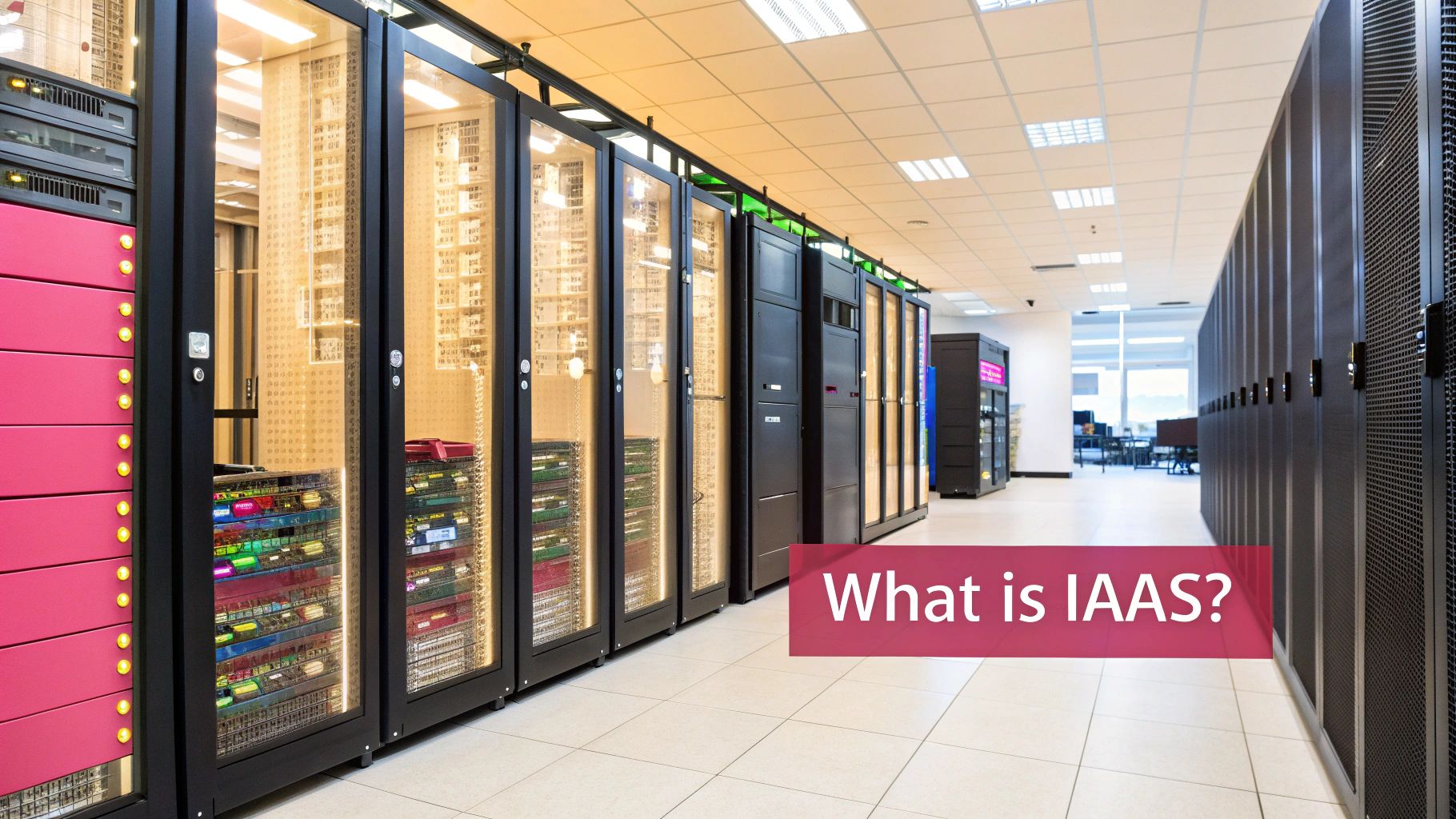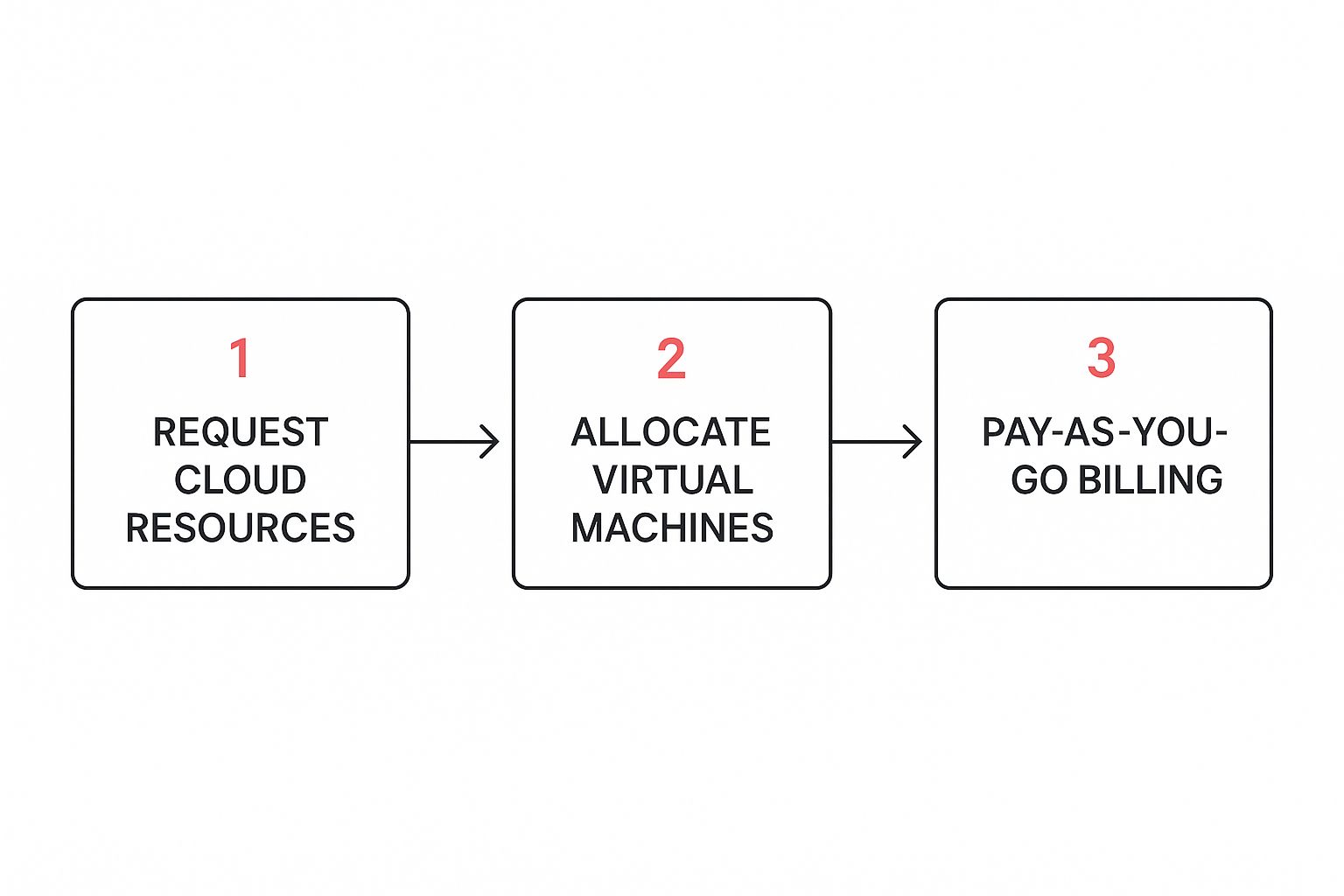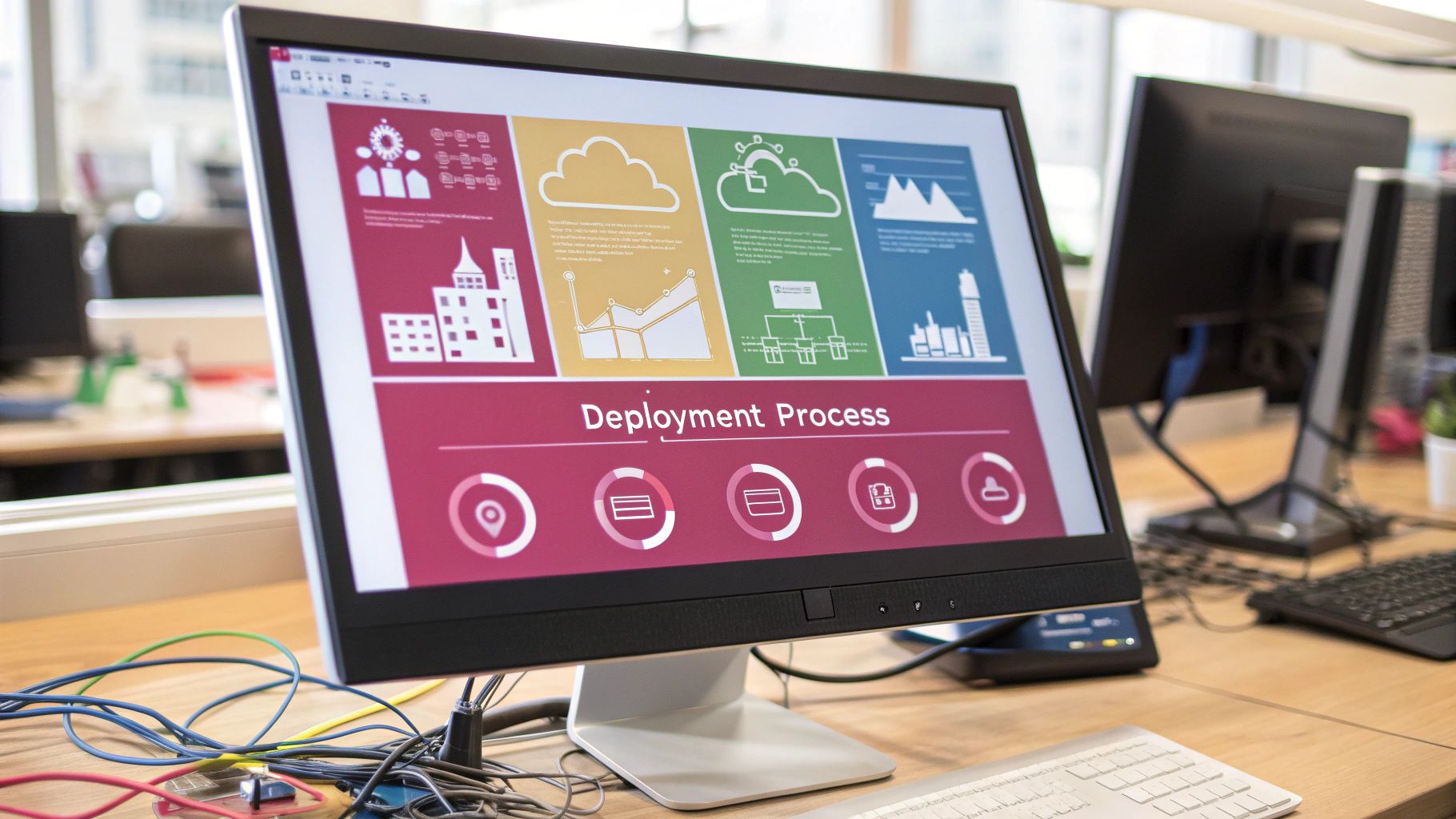What Is Infrastructure as a Service? Essential Guide for UK Businesses
Ever considered leasing a fully-equipped professional kitchen instead of building one from the ground up? That’s an excellent way to think about Infrastructure as a Service (IaaS) for your company's digital operations. At its core, IaaS provides the fundamental building blocks of computing—servers, storage, and networking—over the internet on a flexible, pay-as-you-go basis.
The Foundation of Your Digital Operations
Infrastructure as a Service is essentially a way for businesses to rent their IT hardware from a cloud provider. Instead of buying, housing, and maintaining physical servers in your office, you access these resources through a simple online portal. This move flips your IT spending from a major capital expense (CapEx) to a much more predictable operational cost (OpEx).
Traditionally, a business would have to buy servers, find a secure and climate-controlled space for them, and hire staff for ongoing maintenance. With IaaS, a provider like Amazon Web Services (AWS) or Microsoft Azure takes care of all the physical hardware, security, and upkeep. Your team simply logs in and uses the computing power they need, when they need it.
This approach delivers incredible agility. For instance, a UK-based law firm can spin up a new server environment in minutes to host a secure client data room for a specific case. Once the case concludes, they can shut the server down just as quickly, paying only for the time it was active.

The Power of Virtualisation
The magic that makes IaaS possible is virtualisation. A cloud provider takes a massive physical server and uses special software to slice it into multiple, independent virtual machines (VMs). Each VM behaves like its own self-contained computer, complete with its own operating system and applications, totally isolated from the others. If you're curious about the mechanics, you can learn more about the core principles of server virtualization.
This structure brings some powerful benefits to your business:
- Cost Efficiency: You can say goodbye to the high upfront costs of hardware and the recurring expenses of maintenance, electricity, and physical space.
- Scalability: Instantly scale your resources up or down to meet fluctuating demand. An e-commerce site, for example, can add server capacity for a Black Friday sale and then scale it right back down afterwards.
- Speed: Deploy new servers and applications in a matter of minutes or hours, not the weeks or months it takes to order and install physical hardware.
This flexibility is driving major adoption. The UK cloud computing market, which heavily features IaaS, was valued at approximately $27.48 billion and is forecasted to grow to $97.21 billion by 2033.
This growth isn't just a number; it highlights a real strategic shift as businesses move towards more agile and cost-effective IT models.
IaaS vs Traditional On-Premise IT
To really appreciate the difference, let's look at a side-by-side comparison. It quickly becomes clear why so many businesses are making the switch.
| Aspect | Infrastructure as a Service (IaaS) | Traditional On-Premise IT |
|---|---|---|
| Hardware | Rented from a cloud provider. No physical hardware ownership. | Purchased and owned by the business. |
| Management | Provider manages physical servers, storage, and networking. You manage VMs and OS. | Your IT team manages everything: hardware, maintenance, security, cooling. |
| Cost Model | Operational Expense (OpEx) – pay-as-you-go, subscription-based. | Capital Expense (CapEx) – large upfront investment, plus ongoing costs. |
| Scalability | On-demand. Scale resources up or down in minutes. | Limited. Requires purchasing and installing new hardware, which takes time. |
| Deployment Speed | Fast. New servers can be provisioned within minutes. | Slow. Can take weeks or months to procure and set up new hardware. |
| Maintenance | Handled by the provider. No physical maintenance for your team. | Your responsibility. Includes hardware repairs, replacements, and software updates. |
The table makes the contrast stark. IaaS offers a dynamic, service-based model, freeing you from the burdens of physical infrastructure. On the other hand, traditional IT provides complete control but at a significant cost in terms of money, time, and flexibility.
How IaaS Works Behind the Scenes
To really understand what Infrastructure as a Service is all about, it helps to lift the bonnet and have a look at the engine. The technology making it all possible is virtualisation. Cloud providers run enormous, powerful physical servers in highly secure data centres. Virtualisation is what allows them to digitally carve up these massive servers into multiple, separate virtual machines (VMs).
Let's try an analogy. Picture a large office building. The building itself is the physical server, but it's partitioned into dozens of individual, secure office suites – these are the VMs. Each office is its own self-contained space, but they all share the building's core services like electricity, water, and security. In the same way, each VM functions like a standalone computer, yet it pulls its processing power from the shared physical hardware.
From Request to Resource
This virtualised environment is what makes IaaS so responsive and flexible. Using a straightforward web portal or an API (Application Programming Interface), your IT team can request the exact resources they need – a specific amount of processing power (CPU), memory (RAM), and storage. The provider's automated system then spins up a VM with those precise specifications, almost instantly.
Imagine a professional services firm in Hampshire needs to launch a new portal for its clients. They can request a server with a particular configuration and, within minutes, a fresh virtual server is ready to go. All that's left is for them to install their chosen operating system and applications. This completely sidesteps the old, cumbersome process of ordering physical hardware, waiting for delivery, and then spending days setting it all up.
At its heart, the whole system operates on a shared responsibility model. The IaaS provider is responsible for managing the physical kit—the servers, the storage, the networking gear—while you manage the virtual machines, operating systems, and whatever you choose to build on top.
This process really shines a light on the core efficiency of IaaS. You get direct control over your digital hardware without ever having to physically touch a single component. The simple, three-step workflow is shown below.

As you can see, the model is beautifully simple: you ask for the resources you need, the provider allocates them from their vast pool, and you’re billed just for what you use. This pay-as-you-go delivery is backed by a robust and expanding network of data centres right here in the UK.
The Backbone of On-Demand Infrastructure
These physical data centres are the true, unsung heroes of the IaaS world. The UK data centre as a service market is projected to grow at a staggering compound annual growth rate (CAGR) of 28.8% between 2024 and 2030. Servers alone account for over 60% of this market's revenue.
This huge investment in local infrastructure is what underpins the high availability and low-latency performance that British businesses depend on. You can dive deeper into the UK data centre market growth on Grand View Research.
The Strategic Advantages for Your Business
Moving beyond the technical details, the real value of Infrastructure as a Service comes from what it does for your business strategy. This isn't just another IT decision; it's a fundamental change that turns your technology from a fixed cost into a flexible engine for growth.
It all starts with your budget. IaaS frees you from the hefty, upfront Capital Expenditures (CapEx) needed for physical hardware. Instead of unpredictable, large investments, you get a consistent, manageable Operational Expenditure (OpEx). This makes financial planning much, much simpler.

Unlocking Unmatched Scalability and Agility
One of the biggest game-changers with IaaS is its incredible scalability. Your business can react to market changes almost instantly, without being held back by the servers sitting in your office.
Think about a UK e-commerce shop gearing up for Black Friday. In the past, they would have had to buy and install extra servers, hoping they had enough capacity. With IaaS, they can spin up additional resources to handle the massive rush of shoppers, and then scale right back down once the sale is over. The best part? They only pay for the resources they actually used. This agility prevents wasted money and ensures a seamless experience for customers, even during the busiest periods.
The core benefit is paying for what you need, when you need it. This flexibility allows businesses to experiment, innovate, and grow without the financial risk associated with purchasing expensive, dedicated servers that might sit idle for much of the year.
This pay-as-you-go approach is a major reason the global IaaS market is growing so fast. From a value of around USD 156.93 billion, the market is forecast to hit approximately USD 712.46 billion by 2032. This phenomenal growth is driven by businesses across the UK and the world looking to operate more efficiently. You can find out more by exploring the latest research on the IaaS market.
Bolstering Business Continuity and Security
In a world full of uncertainties, keeping your business running through any disruption is critical. IaaS offers a level of disaster recovery and business continuity that would be incredibly expensive for most small or medium-sized businesses to build on their own.
Here’s how it strengthens your operational resilience:
- Automated Backups: IaaS providers have robust, automated backup systems. Your crucial data is regularly copied to secure, off-site data centres, protecting it from local disasters like fire, flood, or theft.
- Rapid Recovery: If a server fails or you face a cyber-attack, you can quickly get back online using your cloud-based backups. This ability drastically cuts down on costly downtime.
- Geographic Redundancy: Hosting your infrastructure across a provider's multiple, geographically separate data centres means you don't have a single point of failure. A power cut in one region won't bring your entire operation to a halt.
This built-in resilience also improves your security. Major IaaS providers pour millions into physical and digital security protocols that are far beyond what most individual companies can afford. While the provider handles the security of the core infrastructure, remember that you are still responsible for securing your own data and applications. You can learn more by reading about the five cyber security threats managed services can shield your business from.
Practical IaaS Use Cases in Action

The theory behind Infrastructure as a Service is one thing, but seeing it solve real-world business problems is where its value truly clicks. When you move past the abstract definitions, you start to see just how flexible IaaS can be for UK small and medium-sized enterprises (SMEs).
Let's look at a few common scenarios where IaaS offers a direct, effective, and surprisingly cost-efficient solution. These examples show how professional services firms can turn on-demand infrastructure into a genuine competitive edge.
Hosting a High-Traffic Website or E-Commerce Store
Picture a growing online gift shop based in Dorset. Most of the year, their website traffic is predictable. But come Christmas or Black Friday, it skyrockets. With their own physical servers, they’d face a painful choice: invest in powerful, expensive hardware that sits idle for months, or risk the website crashing from the surge in visitors, costing them sales and their reputation.
This is a classic problem that IaaS handles beautifully.
- The Solution: The retailer hosts their website on scalable virtual servers with an IaaS provider. For eleven months of the year, they tick along on a modest, low-cost setup.
- The Action: As the Christmas rush approaches, their IT partner can scale up their infrastructure in minutes, adding more processing power and memory to handle thousands of concurrent shoppers.
- The Result: The site stays fast and responsive throughout the sales period, leading to happy customers and maximised revenue. As soon as the rush is over, they scale everything back down, and their costs immediately drop.
Powering Software Development and Testing
Now, consider a software consultancy in Wiltshire that builds bespoke applications. Every new project needs a clean, isolated environment for development and testing. Relying on physical servers for this would be slow and costly, while testing on live systems would be far too risky.
IaaS provides the perfect answer by enabling the rapid creation of disposable 'sandbox' environments. These sandboxes are completely separate from live production systems, allowing developers to experiment freely without any risk of interference.
The team can spin up a new virtual server, configured to a project's exact needs, in less than an hour. They can build the app, run all their tests, and even clone the environment to test multiple scenarios at once. Once the project is finished and deployed, they simply delete the virtual servers, and all related costs stop. This agility massively speeds up project delivery and encourages innovation. The many cloud computing benefits for businesses like this one show why so many firms are making the switch.
Running Big Data Analytics On-Demand
Finally, imagine a professional services firm in Hampshire, such as an accountancy or a marketing agency, that needs to analyse vast datasets to find market trends for its clients. This kind of number-crunching requires huge amounts of computing power, but only for short, intense bursts. Buying and maintaining the high-performance servers needed for this work would be a non-starter; the hardware would likely sit unused 95% of the time.
With IaaS, the firm can essentially rent a supercomputer by the hour. They upload their dataset to the cloud, spin up a cluster of powerful virtual machines to process the information, and shut them all down when the analysis is done. This approach turns a massive capital expenditure into a small, manageable operational cost, allowing the firm to offer advanced data services that would otherwise be completely out of reach.
Choosing the Right IaaS Provider and Model
Picking the right Infrastructure as a Service setup isn’t just another IT decision. It’s a strategic choice that will shape your budget, your security posture, and your ability to adapt for years to come. To get it right, you first need to get your head around the different ways IaaS can be deployed and then know exactly what to look for in a provider.
The first piece of the puzzle is deciding which IaaS model—public, private, or hybrid—actually fits your business. This is the foundation upon which everything else is built, as it dictates how you’ll manage and pay for your cloud resources.
Public, Private, or Hybrid: Which Is Right for You?
The model you choose ultimately comes down to who owns and manages the underlying hardware. Each option has its own trade-offs, particularly when it comes to cost, security, and how much control you want to retain.
-
Public Cloud: This is the model most people think of. A provider like Amazon Web Services (AWS) or Microsoft Azure owns and operates massive data centres, and you rent a slice of that infrastructure over the internet. It’s incredibly flexible and cost-effective, making it a natural fit for startups, websites with unpredictable traffic, and development teams that need to spin up environments quickly.
-
Private Cloud: Think of this as your own personal cloud. The infrastructure is dedicated entirely to your organisation. You can build it yourself on-premise or have a third party host and manage it for you. The big win here is maximum control and security, which is why it’s often the go-to for businesses in heavily regulated sectors like finance or healthcare that simply cannot compromise on data privacy.
-
Hybrid Cloud: Why choose one when you can have both? A hybrid approach combines public and private clouds, letting you move data and applications between them as needed. You might keep your sensitive client data in a secure private cloud while using the public cloud’s scalability for your front-end website or for disaster recovery. It offers a fantastic balance between security and flexibility.
At its core, the decision is about matching the model to the job at hand. A public cloud is brilliant for cost-sensitive, flexible tasks. For workloads that demand serious security and compliance, a private or hybrid setup is a much safer bet.
Deciding on the best model for your business is a crucial first step. To make that choice a bit clearer, the table below breaks down the key differences between the three main deployment models.
IaaS Deployment Models: A Quick Comparison
| Deployment Model | Best For | Key Advantage | Consideration |
| :— | :— | :— |
| Public Cloud | Startups, e-commerce, test & dev environments. | Maximum scalability and cost-effectiveness. | Shared infrastructure means less control. |
| Private Cloud | Financial services, healthcare, government. | Enhanced security and control over data. | Higher costs and management overhead. |
| Hybrid Cloud | Established businesses with diverse needs. | Balances security with flexible scalability. | Can introduce complexity in management. |
This comparison should give you a good idea of which direction to head in. The next step is finding a partner who can deliver on your chosen model.
A Checklist for Evaluating IaaS Providers
Once you know what kind of IaaS model you need, the spotlight shifts to finding the right provider. For any UK business, some things are simply non-negotiable, especially around where your data lives and how reliable the service is.
Before you sign any contracts, run potential providers through this checklist.
-
UK Data Centre Locations: This is a big one. To stay on the right side of GDPR and ensure data sovereignty, you need to know exactly where your data is stored. Confirm the provider has data centres located within the United Kingdom.
-
Security and Compliance Certifications: Don't just take their word for it. Look for official accreditations like ISO 27001 or Cyber Essentials Plus. These are clear indicators that a provider takes security seriously and has been independently verified.
-
Service Level Agreements (SLAs): Get into the details of the SLA. It should spell out, in no uncertain terms, their uptime guarantee (you should be looking for 99.9% or higher), performance benchmarks, and what happens if they fail to meet them.
-
Transparent Pricing: Cloud billing can get complicated, fast. A good provider will have a clear, predictable pricing model with no nasty surprises for things like data transfer or technical support. They should be able to help you forecast your monthly spend accurately.
-
Responsive UK-Based Support: When something goes wrong—and sooner or later, it will—you need fast, competent help from people who understand your business. Check for 24/7 support and ask about the expertise of their UK-based engineering teams.
Your IaaS Questions, Answered
Even when you’ve got a good handle on what Infrastructure as a Service is, it’s completely normal for UK businesses to have questions before taking the plunge. Moving to the cloud is a big step, and it brings up practical questions about cost, security, and how it really stacks up against other options.
This section tackles the most common queries head-on, giving you the clarity you need to move forward with confidence.
What’s the Difference Between IaaS, PaaS, and SaaS?
This is easily one of the most common points of confusion. The simplest way to get your head around the "as a service" family is with a pizza analogy.
- Software as a Service (SaaS): This is like ordering a hot pizza delivered straight to your door. You get a ready-to-use product (think Gmail or your CRM system), but you have zero control over the ingredients or how it was made. You just enjoy the service.
- Platform as a Service (PaaS): Think of this as a take-and-bake pizza. The dough and toppings are all sorted for you, but you pop it in your own oven. This gives you some control over the final result, much like how a web development platform provides the tools, but you’re the one building the actual application.
- Infrastructure as a Service (IaaS): Now, this is like being handed flour, water, and fresh toppings in a fully equipped professional kitchen. You have complete freedom to make any kind of pizza you can dream up, from scratch. You control the operating system and the applications, which offers maximum flexibility but also means more hands-on work.
For any UK business, the right choice really boils down to how much control you need and what technical skills you have in-house.
Is IaaS Secure Enough for Our Business Data?
Absolutely. In fact, IaaS is often far more secure than a typical on-premise setup. The major providers invest millions in physical and digital security protocols—a level of protection that’s simply not feasible for most small to medium-sized enterprises (SMEs).
It's vital to remember, though, that IaaS works on a shared responsibility model. The provider is responsible for securing the global infrastructure (the data centres, physical servers, and network), but you are responsible for securing everything you build on top of it.
This means it's up to your team to properly configure firewalls, manage user access permissions, and lock down your virtual machines and applications. For UK businesses, it’s also crucial to work with a provider who is GDPR-compliant and can guarantee your data stays within the UK, especially if your industry or clients require it.
How Does IaaS Pricing Work? Will It Actually Save Us Money?
IaaS almost always runs on a pay-as-you-go model. You’re only billed for the computing resources you consume, often measured by the hour or even by the minute. This completely flips the script on IT budgeting, transforming large, upfront Capital Expenditures (CapEx) into predictable, monthly Operational Expenditures (OpEx).
For many SMEs, this shift can unlock some serious savings. You no longer have to worry about the costs of:
- Buying expensive server hardware upfront.
- Ongoing maintenance, repairs, and upgrades.
- The hefty electricity bills for powering and cooling a server room.
- The physical office space needed to house all that equipment.
You can cut costs even further by simply turning off resources when they aren't being used, like shutting down development servers overnight or at the weekend. For more predictable, long-term workloads, providers also offer significant discounts if you commit to using resources for a one or three-year term, adding another powerful way to manage your budget.
At SES Computers, we have over 30 years of experience helping businesses across Dorset, Hampshire, Wiltshire, and Somerset find their footing in the cloud. From picking the right service model to ensuring your data is secure and compliant, our team provides the expert guidance and UK-based support you need to make a successful move to IaaS. Find out how our managed cloud services can improve your operations by visiting us at https://www.sescomputers.com.